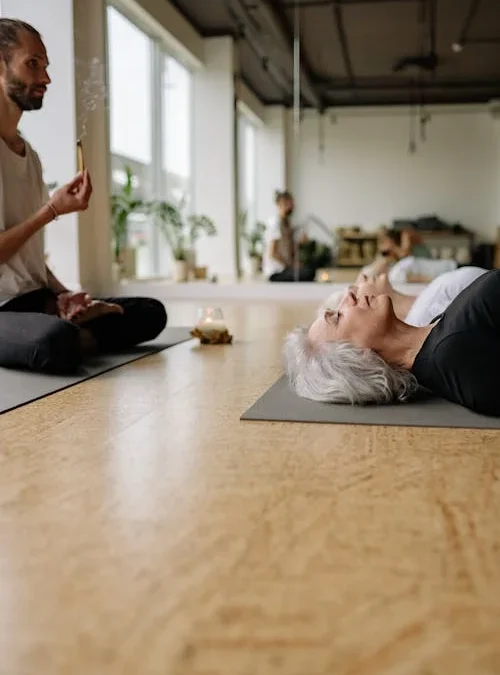Getting a good night’s sleep is very important for our health. Yet, many people find it hard to fall asleep or stay asleep through the night. If you are one of those people, yoga might help you. Yoga for better sleep is a gentle and effective way to relax your body and mind, helping you drift off more easily.
Why Yoga for Better Sleep?
Yoga for better sleep works by calming your nervous system and reducing stress. When you are less stressed, your body can relax, and you can sleep better. Yoga involves slow, mindful movements and deep breathing, which help to slow down your heart rate and lower your blood pressure. This makes it easier to relax and fall asleep.
Simple Evening Yoga Routine
Here is a simple evening yoga routine for better sleep. You can do these poses about 30 minutes before you go to bed. Make sure to do them in a quiet space where you can relax. Wear comfortable clothes and use a yoga mat if you have one.
1. Child’s Pose (Balasana)
Child’s Pose is a restful pose that helps to calm the mind and relieve tension in the body.
Kneel on the floor with your big toes touching and knees spread apart. Sit back on your heels and stretch your arms forward on the floor. Rest your forehead on the mat. Breathe deeply and stay in this pose for 2-3 minutes.
2. Cat-Cow Pose (Marjaryasana-Bitilasana)
Cat-Cow Pose helps to gently stretch and warm up the spine. It also massages your organs and improves blood flow, which can help with relaxation.
Start on your hands and knees in a tabletop position. As you inhale, drop your belly towards the mat and lift your head and tailbone towards the ceiling (Cow Pose). As you exhale, round your spine towards the ceiling and tuck your chin to your chest (Cat Pose). Continue to flow between these two poses for 1-2 minutes, matching your breath to your movements.
3. Forward Bend (Uttanasana)
Forward Bend helps to relieve tension in your back, shoulders, and neck. It also calms your mind and helps to reduce stress.
Stand with your feet hip-width apart. Hinge at your hips and fold forward, letting your arms and head hang towards the floor. You can bend your knees slightly if you need to. Hold this pose for 1-2 minutes, taking deep breaths.
4. Legs Up the Wall (Viparita Karani)
Legs Up the Wall is a restorative pose that helps to reduce swelling in your legs and feet. It also promotes relaxation and can help to quiet your mind.
Sit with one side of your body against a wall. Lie down on your back and swing your legs up the wall. Your body should form an L shape. Rest your arms by your sides, with your palms facing up. Close your eyes and stay in this pose for 5-10 minutes.
5. Reclining Bound Angle Pose (Supta Baddha Konasana)
Reclining Bound Angle Pose helps to open your hips and chest. It also promotes deep relaxation and can help to calm your nervous system.
Lie on your back and bring the soles of your feet together, letting your knees fall open to the sides. Place your arms by your sides with your palms facing up. If this is uncomfortable, you can place pillows under your knees for support. Close your eyes and breathe deeply, staying in this pose for 5-10 minutes.
6. Corpse Pose (Savasana)
Corpse Pose is the final relaxation pose in yoga. It helps to relax your entire body and mind, preparing you for sleep.
Lie on your back with your legs straight and arms by your sides. Close your eyes and take slow, deep breaths. Focus on relaxing each part of your body, starting from your toes and working your way up to your head. Stay in this pose for 5-10 minutes.
Tips for Practicing Yoga for Better Sleep
Consistency is key when practicing yoga for better sleep. Try to do your routine every evening to help your body get used to relaxing before bed. Stay mindful by focusing on your breath and body movements, which will help you stay present and release stress. Create a calming environment with dim lights, soft music, and a quiet space. Avoid stimulants such as caffeine, heavy meals, and intense exercise before bedtime as they can interfere with sleep.
Benefits of Yoga for Better Sleep
Regular yoga practice can improve sleep quality, helping you fall asleep faster and stay asleep longer, leading to feeling more rested upon waking. It helps reduce stress by lowering cortisol levels, making it easier to relax and sleep. Yoga also enhances physical health by improving flexibility, strength, and balance, while relieving muscle tension, making it easier to get comfortable in bed. Additionally, yoga can boost mental health by reducing anxiety and depression, which are common sleep disruptors.
Conclusion
Incorporating yoga for better sleep into your evening routine can significantly improve your sleep quality. By practicing a few gentle poses before bed, you can relax your body and mind, easing into sleep more naturally. Remember to practice consistently and create a calming environment for your yoga sessions. Over time, yoga can become an essential part of your bedtime routine, helping you sleep better and wake up refreshed.

